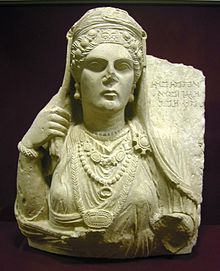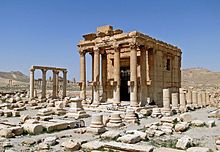Palmyra
From Wikipedia, the free encyclopedia
For places named Palmyra after this city, see Palmyra (disambiguation).
| Palmyra تدمر | |
|---|---|
| Palmyra and Temple of Bel | |
| | |
| Coordinates: 34°33′36″N 38°16′2″E / 34.56°N 38.26722°E | |
| Country | |
| Governorate | Homs Governorate |
| District | Palmyra District |
| Elevation | 405 m (1,329 ft) |
| Area code(s) | 31 |
| Site of Palmyra* | |
|---|---|
| UNESCO World Heritage Site | |
 | |
| State Party | |
| Type | Cultural |
| Criteria | i, ii, iv |
| Reference | 23 |
| Region** | List of World Heritage Sites in the Arab States |
| Inscription history | |
| Inscription | 1980 (4th Session) |
| * Name as inscribed on World Heritage List. ** Region as classified by UNESCO. | |
Though the ancient site fell into disuse after the 16th century, it is still known as Tadmor in Arabic, and there is a newer town next to the ruins of the same name. The Palmyrenes constructed a series of large-scale monuments containing funerary art such as limestone slabs with human busts representing the deceased.
Culture
Palmyrans were of Arab ethnicity [4]; they bore Arabic names, and worshipped Arabic deities such as: Hubal, Ruda, Ma'nu, Allat, Baal, and Munaf. Palmyrans were originally speakers of a North Arabian dialect; then they adopted Aramaic as an official language thus becoming bilingual [5], but later shifted from Aramaic into Latin. In the time of the Islamic conquests Palmyra was inhabited by several Arab tribes, primarily Qada'ah and Kalb among others.[6]History
Ancient
The exact etymology of the name "Palmyra" is unknown, although some scholars believe it was related to the palm trees in the area. Others, however, believe it may have come out of an incorrect translation of the name "Tadmor" (cf. Colledge, Seyrig, Starcky, and others). The city was first mentioned in the archives of Mari in the second millennium BC. It was another trading city in the extensive trade network that linked Mesopotamia and northern Syria. Tadmor is mentioned in the Hebrew Bible (Second Book of Chronicles 8:4) as a desert city built (or fortified) by the King Solomon of Judea:Flavius Josephus also attributes the founding of Tadmor to Solomon in his Antiquities of the Jews (Book VIII), along with the Greek name of Palmyra, although this must be a confusion with biblical 'Tamara'. Several citations in the tractates of the Talmud and of the Midrash also refer to the city in the Syrian desert (sometimes interchanging the letters "d" and "t" - "Tatmor" instead of "Tadmor").There had been a temple at Palmyra for 2000 years before the Romans ever saw it. Its form, a large stone-walled chamber with columns outside, is much closer to the sort of thing attributed to Solomon than to anything Roman. It is mentioned in the Bible as part of Solomon's Kingdom. In fact, it says he built it.—Terry Jones and Alan Ereira, Terry Jones' Barbarians, p. 183
Greco-Roman periods

Inscription of Queen Zenobia at Palmyra.
In the mid 1st century AD, Palmyra, a wealthy and elegant city located along the caravan routes linking Persia with the Mediterranean ports of Roman Syria and Phoenicia, came under Roman control. During the following period of great prosperity.
Jones and Erieira note that Palmyran merchants owned ships in Italian waters and controlled the Indian silk trade. "Palmyra became one of the richest cities of the Near East." "The Palmyrans had really pulled off a great trick, they were the only people who managed to live alongside Rome without being Romanized. They simply pretended to be Romans."
Palmyra was made part of the Roman province of Syria during the reign of Tiberius (14 –37 AD). It steadily grew in importance as a trade route linking Persia, India, China, and the Roman empire. In 129, Hadrian visited the city and was so enthralled by it that he proclaimed it a free city and renamed it Palmyra Hadriana.
Beginning in 212, Palmyra's trade diminished as the Sassanids occupied the mouth of the Tigris and the Euphrates. Septimius Odaenathus, a Prince of Palmyra, was appointed by Valerian as the governor of the province of Syria. After Valerian was captured by the Sassanids and died in captivity in Bishapur, Odaenathus campaigned as far as Ctesiphon (near modern-day Baghdad) for revenge, invading the city twice. When Odaenathus was assassinated by his nephew Maconius, his wife Septimia Zenobia took power, ruling Palmyra on the behalf of her son, Vabalathus.
Zenobia rebelled against Roman authority with the help of Cassius Longinus and took over Bosra and lands as far to the west as Egypt, establishing the short-lived Palmyrene Empire. Next, she took Antioch and large sections of Asia Minor to the north. In 272, the Roman Emperor Aurelian finally restored Roman control and Palmyra was besieged and sacked, never to recover her former glory. Aurelian captured Zenobia, bringing her back to Rome. He paraded her in golden chains but allowed her to retire to a villa in Tibur, where she took an active part in society for years. A legionary fortress was established in Palmyra and although no longer an important trade center, it nevertheless remained an important junction of Roman roads in the Syrian desert.[8]
Diocletian expanded it to harbor even more legions and walled it in to try and save it from the Sassanid threat. The Byzantine period following the Roman Empire only resulted in the building of a few churches; much of the city turned to ruin.
Islamic rule
The city was captured by the Muslim Arabs under Khalid ibn Walid in 634. Palmyra was kept intact. After the year 800 and the civil wars which followed the fall of the Umayyad caliphs, people started abandoning the city. At the time of the Crusades, Palmyra was under the Burid emirs of Damascus, then under Tughtekin, Mohammed the son of Shirkuh, and finally under the emirs of Homs. In 1132 the Burids had the Temple of Ba'al turned into a fortress. In the 13th century the city was handed over to the Mamluk sultan Baybars. In 1401, it was sacked by Tamerlan, but it recovered quickly, so that in the 15th century it was described as boasting "vast gardens, flourishing trades and bizarre monuments" by Ibn Fadlallah al-Omari.In the 16th century, Qala'at ibn Maan castle was built on top of a mountain overlooking the oasis by Fakhr ad-Din al-Maan II, a Lebanese prince who tried to control the Syrian Desert. The castle was surrounded by a moat, with access only available through a drawbridge. It is possible that earlier fortifications existed on the hill well before then.
The city declined under Ottoman rule, reducing to no more than an oasis village with a small garrison. In the 17th century its location was rediscovered by western travellers, beginning to be studied by European and American archaeologists starting from the 19th centuries. The villagers who had settled in the Temple of Ba'al were dislodged in 1929 by the French authority.
Main sights
City remains
The most striking building in Palmyra is the huge temple of Ba'al 34°32'50.55"N 38°16'26.72"E, considered "the most important religious building of the first century AD in the Middle East".[9] It originated as a Hellenistic temple, of which only fragments of stones survive. The central shrine (cella) was added in the early 1st century AD, followed by a large double colonnaded portico in Corynthian style. The west portico and the entrance (propylaeum) date from the 2nd century. The temple measures 205 x 210 m.Starting from the temple, a colonnaded street, corresponding to the ancient decumanus, leads to the rest of the ancient city. It has a monumental arch 34°32'59.68"N 38°16'15.66"E (dating to reign of Septimius Severus, early 3rd century AD) with rich decorations. Next were a temple of Nabu, of which little remains today apart from the podium, and the so-called baths of Diocletian.
The second most noteworthy remain in Palmyra is the theater 34°33'2.11"N 38°16'7.78"E, today having nine rows of seating, but most likely having up to twelve with the addition of wooden structures.[10] It has been dated to the early 1st century AD. Behind the theater were a small Senate, where the local nobility discussed laws and political decisions, and the so-called "Tariff Court", which an inscription led to think to be a custom for caravans' payments. Nearby is the large agora 34°33'1.82"N 38°16'2.01"E (measuring 48 x 71 m), with remains of a banquet room (triclinium); the agora's entrance was decorated with statues of Septimius Severus and his family.
The first section of the excavations ends with a largely restored tetrapylon ("Four columns"), a platform with four sets each with four columns (only one of the originals in Egyptian granite still visible). A transverse streets leads to the Diocletian's Camp, built by the Governor of Syria Sosianus Hierocles,[11] with the remains of the large central principia (Hall housing the legions' standards). Nearby are the Temple of the Syrian goddess Allāt (2nd century AD.), the Damascus Gate and the Temple of Ba'al-Shamin, erected in AD 17 and later expanded under the reign of Odenathus. Remains include a notable portico leading to the cella.
Funerary art

Funerary bust of a woman. Palmyra. Mid-late 2nd century. British Museum.
These reliefs represented the "personality" or "soul" of the person interred and formed part of the wall decoration inside the tomb chamber. A banquet scene as depicted on this relief would have been displayed in a family tomb rather than that of an individual.
Further excavations
Archaeological teams from various countries have been working on-and-off on different parts of the site. In May 2005, a Polish team excavating at the Lat temple discovered a highly-detailed stone statue of the winged goddess of victory Nike.Recently, archaeologists in central Syria have unearthed the remnants of a 1,200-year-old church believed to be the largest ever discovered in Syria, at an excavation site in the ancient town of Palmyra. The church is the fourth to be discovered in Palmyra. Officials described the church as the biggest of its kind to be found so far — its base measuring an impressive 51 by 30 yards. The church columns were estimated to be 20 feet tall, with the height of the wooden ceiling more than 49 feet. A small amphitheater was found in the church's courtyard where the experts believe some Christian rituals were practiced.[12] In November 2010 Austrian media manager Helmut Thoma admitted the looting of an Palmyrian grave, where he has stolen architectural pieces, today presented in his private living room.[13] German and Austrian archaeologists protested against this crime.[14][15]

Temple of Bel.
See also
Notes
- ^ Syria uncovers 'largest church' BBC News Online, 14 November 2008. Retrieved 2008-11-16.
- ^ Palmyra (Syria) -- Britannica Online Encyclopedia Retrieved 2008-11-16.
- ^ Syria Gate - About Syria - Palmyra Retrieved 2008-11-16.
- ^ Encyclopedia Britannica 1911, v.20, p.654
- ^ Zenobia between reality and legend, Yasmin Zahran .pp 35-36
- ^ Byzantium and the Arabs in the Sixth Century, Irfan Shahîd, v.2 part 2, p.256
- ^ Isaac (2000), pp. 141-142
- ^ Isaac (2000), p. 165
- ^ Ross (1999), p. 165
- ^ Ross (1999), p. 169
- ^ Ross (1999), p. 171
- ^ "1,200-year-old church uncovered in Syria". The Associated Press. http://ap.google.com/article/ALeqM5jAzBSBOFJhi4iTgpaNylsy6RhH9QD94E2QE80. Retrieved 2008-11-13.
- ^ http://www.archnews.co.uk/world-archaeology/european-archaeology/4148-austrian-german-media-manager-plundered-unesco-world-heritage.html Article on Helmut Thoma's looting of Palmyrian grave
- ^ Epoc - Interview with Austrian archaeologist working in Palmyra on the occasion of Helmut Thoma's looting
- ^ swr - "Grabraub ist kein Kavaliersdelikt". a comment on Helmut Thoma's looting
Bibliography
- Burns, Ross (1999). Monuments of Syria. London and New York: I.B. Tauris. pp. 162–175.
- Isaac, Benjamin (2000). The Limits of Empire - the Roman Army in the East (revised ed.). Oxford: Clarendon Press.













No comments:
Post a Comment